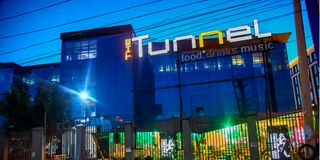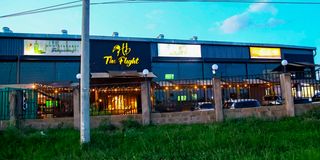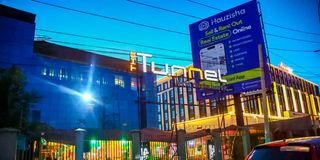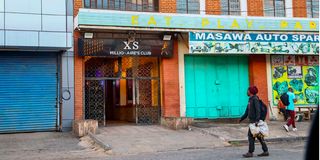
The Tunnel Club along Mombasa Road, Nairobi on March 6, 2024.
It is barely dusk but the party mood on Baricho Road is already building to an ecstatic level. Baricho Road is one of the streets in Nairobi’s Industrial Area, Kenya’s manufacturing hub which has unfortunately suffered from years of neglect and ineptitude.
The cheerfulness of the colourfully dressed revellers basking in the weekend mood contrasts sharply with the sombre mood of the retiring grease-laden mechanics outside the garages, which overlook a row of glittery nightclubs such as XS Millionaires, The Legend, and Club Asylum.
Over the years, the rhythmic purr of the machines from the factories along this thoroughfare has been drowned out by the bombastic blare of Afro Beats, Gengetone and Bongo Flava tunes. The consumers have been taking over as the producers retreat.
There is no better way to sum up the uneventful capitulation of Kenya’s manufacturing sector under the growing weight of the service sector than how the factories in Industrial Area are giving way to pubs and nightclubs.
If, as some people have said, Kenya’s manufacturing sector is a graveyard, on Baricho Road Kenyans have literally been dancing on some of its graves.

Hornbill The Flight Club along Northern Airport Road, Nairobi on March 6, 2024.
Virtually all the nightclubs here were once either factories or warehouses.
“It (Baricho Road) was industrial. It was very industrial,” says Sammy Kahama, the proprietor of K1 Kub House, which was among the first to set up here.
For their branch on Baricho Road, known as K2, the Kahamas converted an open warehouse into a pub that Sammy described as “hottest pub in Nairobi” until they later shut it, partly because the rents became prohibitively high.
Mr Kahama recalls that some of their neighbours included a wood-making company as well as dozens of factories that sold spare parts.
“Actually, most people at Baricho Road were selling tools,” he says.
These shops would then feed the car repair works that were done by the many garages and car assembly plants around.
The spark that turned Baricho Road into a hedonistic hotspot was Choices Pub and Restaurant, popularly known as ‘Ka Choi,’ started in 2000.
Choices would then be followed by K2 before nearly the entire thoroughfare was colonised by drinking dens.
“Why would the Baricho area have nightclubs when it is in the Industrial Area? It is not the workers of the industries coming to dance and drink there, it is the residents, right?” poses Bobby Johnson, the director at Steelmakers Limited, one of the manufacturing companies that relocated from the Industrial Area.
The allure of an expanding middle class community around—from South C across the road to Karen— was the main reason Baricho Road was converted into a party street.
Indeed, the most documented encroachment on the Industrial Area has been from residential houses. Along Mombasa Road, not very far from the East Africa Spectre, which manufactures gas cylinders, is a gated community complete with a school and other social amenities.
The residents are oblivious to the pungent smell coming from Spectre, a company that is associated with the former Prime Minister Raila Odinga.

The Tunnel Club along Mombasa Road, Nairobi on March 6, 2024.
The construction of Great Wall Housing in Athi River, another budding industrial zone, by a Chinese investor, has led to numerous conflicts between the residents and London Distillers, an alcohol manufacturer.
The residents of this estate have complained that London Distillers emptied toxic waste water into the environment, leading to discomfort and diseases. Some parts of the Industrial Area, which were fed by the railway lines, and which are now disused, have been taken over by informal settlements, forcing some companies to close down after their complaints landed on deaf ears, says Antony Mwangi, the chief executive officer of the Kenya Association of Manufacturers (KAM).
Now, the latest invasion is by nightclubs which have come under pressure whenever they have operated in residential places. They have lost their appeal in the central business district (CBD) where restaurants have been edging them out. And most of them find the malls expensive.
At Baricho Road, nightclubs only have silent factories for neighbours at night.
“It is actually the ideal place to set up a club because you are not disturbing any resident with your traffic and your operations,” said a proprietor of one of the nightclubs along Baricho who asked to remain anonymous.
“And then since everyone else operates during the day, we have the whole street to ourselves at night.”
Nairobi’s binge drinking caught on in the early 2000s when the National Rainbow Coalition (Narc) came to power and then President Mwai Kibaki rolled back the 24 years of stagnation that had been presided over by his predecessor.
Official data shows that consumption of beer in post-independence Kenya touched an all-time high of 28 litres per adult in a year in 1981 due to the fall in real prices and the control of beer prices by the government.
However, after the lifting of price controls in early 1990s, beer consumption slumped to a record low of 11 litres in 2002, with the East African Breweries Limited (EABL) forced to relocate its Kisumu factory to Moshi Tanzania citing loss of regional market for the Kenyan beer. But with Mr Kibaki having taken power in 2002, more Kenyans found themselves with extra cash to indulge.
A spending craze emerged that saw the middle class in Nairobi drink beer by the barrels. Beer consumption surged to a high of 19 litres per adult per year in 2012, data from the Kenya Bureau of Statistics (KNBS) shows.
Thus, by the time the KNBS in 2020 reviewed the composition and weights of items in the consumer prices index (CPI), a symbolic shopping basket used by the national statistician to compute the cost of living, the weight of beer had swelled nearly five times from 0.72 to 3.59 for the middle class in Nairobi.
Beer sales as a share of total private consumption rose sharply from 2.0 percent in 2000 to a peak of 4.0 percent in 2008, a study by the Kenya Institute for Public Policy Research and Analysis (Kippra) showed.
The high demand for alcohol saw pubs and nightclubs mushroom everywhere, with concerns being raised about how strip clubs had found their way into residential estates. In 2014 there were 7,200 bars in Nairobi. Two years later when the County Liquor Licensing Board did another count, this number had risen sharply to 12,500, an indicator that residents of Nairobi were splurging on alcohol.
“It is very sad to note that we have more bars and clubs in the country than both primary and secondary schools combined,” said then Interior Cabinet Secretary Fred Matiang’i in 2018.
Baricho Road was turned into a party street as nightclubs offered better rents to landlords while factories and warehouses, bogged down by high cost of production, relocated to cheaper places. Or just closed down.
“With factories, you have all the problems in the world. You have the Kanjos (city council askaris) disturbing you, you have health and safety issues to take care of,” says Mr Johnson.
When most of the machines in these factories around the country were roaring, the value of goods they churned out was over 13 percent of the gross domestic products (GDP). GDP is the value of all goods and services produced in the country in a year.
However, the share of manufacturing to the GDP, official figures show, would fall to a low of 7.0 percent in 2021 before rising marginally to 8.0 percent by end of 2022, way below the 15 percent target for the Jubilee administration, one of the pillars of the Big Four Agenda.
The share of manufacturing did not shrink only because the service sector expanded faster but also because there have been numerous exits from the sector, with most of the proprietors trying their luck in importing the goods rather than manufacturing them.

XS Millionaire's Club along Baricho Road Nairobi on March 6, 2024.
Nightclubs mostly occupied what were initially warehouses—which earlier had been factories.
“What used to be factories of production have been turned into warehouses, because it has become extremely expensive to produce,” says Mr Mwangi.
Half an hour drive from Baricho Road is The Tunnel Club, which is located on Pili Trading Centre. The building is surrounded by factories and warehouses. The Tunnel was clearly hewn out of an open converted warehouse.
Then there is The Flight nightclub on Northern Airport Road, which has all the hallmarks of a massive warehouse. Along Enterprise Road is another beehive of drinking activities in a host of bars and nightclubs which serve the residents of South B estate.
One of the nightclubs along Baricho Road describes itself as “a premier performance night club modelled on the exclusive clubs in London, New York and Paris.”
These cities are the citadels of the post-industrial world. The success of their service industries—from entertainment to banking—have been powered by impeccable industrial hardware built over years, analysts such as the late Kenyan scholar Calestous Juma have argued.
But this has not stopped Nairobi from dreaming big. Kenya’s capital city has been trying to punch above its weight touting its prowess as an ICT hub. Mr Juma criticised this “faulty narrative that assumes that Africa can leap into the service economy without first building a manufacturing base.”
True, the services sector has been the pillar of the Kenyan economy, employing millions of youth who would otherwise have struggled to land decent jobs in the manufacturing sector.
A 2023 World Bank report showed that by the end of 2021, most growth in Kenya had come from the services, which by then contributed 54 percent of GDP and 45 percent of total jobs.
“The development of the services sector is not an alternative to industrialisation but rather can be an enabler of economy-wide growth, including in manufacturing, and agriculture too,” said the World Bank.
The nightclubs are turning into temples of exotic consumption of imported goods. Here there is copious consumption of imported Scotch and Irish whiskeys. Beer from the Netherlands is also popular among the revellers as is wine from France and South Africa. It is a classic example of how Kenya is exporting jobs as it evolves into a society of consumers and not producers.
According to the World Bank, the services which Kenya should prioritise are the kinds that would provide important inputs to both manufacturing and agriculture.
“[Such services] provide the logistics to trade goods, including getting agricultural goods to market, they facilitate technologies used in the production process, and they channel the financing for much-needed investments,” said the World Bank.
But this facilitation has not been happening, with the Industrial Area becoming unattractive to most investors. The Industrial Area is a 9.6-square-kilometre zone that stretches from Bunyala Road near Upper Hill all the way to around City Cabanas.
The creation of the Industrial Area was mooted in a 1948 Master Plan that designated the operation of different industries. According to the plan, industries dealing with bulky goods were located along the railway line. There were feeder lines, the metre gauge line, which went up to the gates of these factories providing last mile connectivity.
Light industries, most of which have since moved to the Kariobangi area, were located closer to the centre of the Industrial Area. There was a strip set aside for noxious industries which were allocated operating places to the East of the old industrial park. Over time, however, the infrastructure in the Industrial Area has been depleted.
“Even for me, when my office was on Mombasa Road, it used to be a nightmare for me to crisscross Mombasa Road,” says Mr Johnson.
This was especially the case when there was the dualling of the 1.7km section of Likoni Road between Lunga Lunga and Jogoo Road. But what was meant to breathe life into the Industrial Area ended up being a pain to manufacturers who grappled with major traffic snarl-ups due to the closure of connecting roads.
The construction of a section of the Enterprise Road, a major artery in the Industrial Area, also took more than a decade to complete, inconveniencing manufacturers as well as other road users.
Power supply is not only expensive, but it is also erratic, forcing a lot of businesses to also invest in generators. This only adds to the cost of production.
The supply of water to industries has also been erratic while the cost of labour has been relatively high compared to neighbouring countries such as Ethiopia.
Consequently, there has been a major exodus of manufacturers from the Industrial Area, leaving vacant go-downs to be taken over by restaurants and nightclubs.
Some of the industries have relocated to other new industrial zones such as Baba Dogo Road, Ruiru and Kitengela.
Other industries have flocked to the new special economic zones (SEZs) such as Tatu City, taking advantage of government incentives such as tax holidays offered in the SEZs.
“This has in a way reduced the relevance of the Industrial Area as the main manufacturing hub,” says Kandie Kandie, the Vice President of Kenya National Chamber of Commerce and Industry’s Manufacturing Committee.
“And from a policy point of view I think the local government was not strict in trying to demarcate industrial areas.”
Other industries have left the country completely. Yana Tyres, which belongs to Sameer Group, left Kenya for Egypt after a bruising competition from cheap tyres from China and India.
Egypt, a member of Common Market for Eastern and Southern Africa (Comesa), a free trade area, together with Kenya, also benefited from the exodus of chocolate-maker Cadbury Kenya and battery maker Eveready in 2014 due to its low cost of power.
“You see, if a business doesn’t pay you money it is okay. But it cannot take money from you,” says Mr Johnson.








